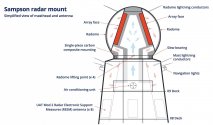This discussion can't really be had if we do not agree with what the likely sensor fit for 054B will be to begin with.
My view is that 054B's radar is a twin faced AESA with each face about 2/3 to 3/4 the size of a single array on 052D, which when considering modern technology, could give 054B's radar performance in the SAMPSON ballpark -- and thus the ability to organically engage long range aerial targets.
If we can agree that 054B will use the 7m long UVLS as well, then when pairing that with the new twin face AESA, I have to ask why the ability to conduct long range engagements (i.e.: integration of the HQ-9 LR SAM) would not be at least capitalized on?
Yeah, I disagree with that.
I think that the ability to reach out to longer ranges *may* be a factor in differentiating between surface combatants, but magazine depth and simultaneous target engagement capability are as important if not more important.
Certainly nothing could stop the new radar from working with the HHQ-9 if you want the integration. This is about two devices talking to each other.
The one missing piece of the puzzle is that the radar and the computers have to update the missile in flight. For a 300km missile, if we assume the terminal seeker has a range of 30km, the missile still has to be guided from the surface for at least 270km until the seeker is range of the target to be autonomous. This calls for a long range datalink.
For this to happen you need to redeploy the datalink from the Type 346A array. The datalink should be the C-band arrays on the top and bottom of the Type 346 array face on the 052C, but on the 052D and Type 346A, the shape of the array dictates that the datalink array might have been moved to the corners of the array. On the 055 and Type 346B, I suspect the datalink is removed completely from the main array and placed somewhere else, which I suspect are on the bridge wings of the ship or on the large bars on top of the bridge. Either for the 054B you have to create a new datalink, or use the set on the 055. The datalinks alone should resemble like a set of flat squares and expected to be phase arrays. If you have longer ranged HHQ-16, you will also likely need a longer ranged datalink.
I do expect the datalink to be used and shared with the 3-5 missiles. In turn, the available radio channels of the datalink can be limited, let's say, for example, 16, so you can have a maximum of 16 missiles on air simultaneously, that's any mix of HHQ-9 and 3-5.

